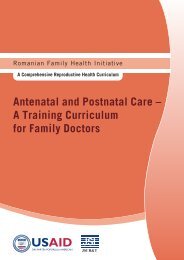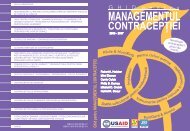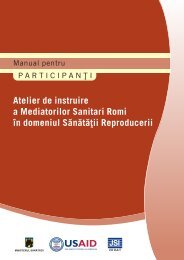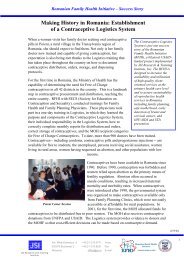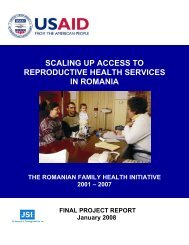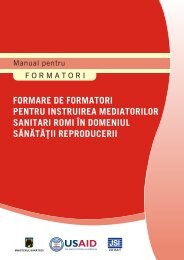Training of Roma Health Mediators in Reproductive Health
Training of Roma Health Mediators in Reproductive Health
Training of Roma Health Mediators in Reproductive Health
Create successful ePaper yourself
Turn your PDF publications into a flip-book with our unique Google optimized e-Paper software.
o Ask about previous breastfeed<strong>in</strong>g experience<br />
o Discuss (as appropriate):<br />
• When to start breastfeed<strong>in</strong>g and to cont<strong>in</strong>ue as long as possible (ideally until<br />
the baby is two years-old)<br />
• Basic pr<strong>in</strong>ciples <strong>of</strong> breastfeed<strong>in</strong>g<br />
• Correct position dur<strong>in</strong>g breastfeed<strong>in</strong>g<br />
• Care <strong>of</strong> the breasts dur<strong>in</strong>g breastfeed<strong>in</strong>g<br />
• Common discomforts and how to deal with them<br />
• Nutritional needs <strong>of</strong> the mother, her health and fertility<br />
o Check/observe breastfeed<strong>in</strong>g position and technique, and <strong>of</strong>fer suggestions if<br />
necessary<br />
o Provide emotional support as necessary<br />
• Express empathy and understand<strong>in</strong>g <strong>of</strong> a mother’s feel<strong>in</strong>gs when talk<strong>in</strong>g to<br />
her.<br />
• Express confidence <strong>in</strong> the mother to make her feel good and build her<br />
confidence<br />
o Involve the whole family <strong>in</strong> newborn care and <strong>in</strong> support<strong>in</strong>g the mother<br />
Conclusions:<br />
<strong>Mediators</strong> should ensure that the follow<strong>in</strong>g messages are communicated to the<br />
community (to mothers and women <strong>of</strong> reproductive age, and to families expect<strong>in</strong>g a<br />
child)<br />
• Beg<strong>in</strong> breastfeed<strong>in</strong>g immediately after delivery. Dur<strong>in</strong>g the first three days, it is<br />
especially important to feed the baby with colostrum, the thick yellowish fluid which<br />
is rich <strong>in</strong> antibodies, prote<strong>in</strong>s, and vitam<strong>in</strong>s.<br />
• Feed frequently, both day and night, whenever the baby is hungry.<br />
• Feed from both breasts.<br />
• Feed at least every four hours, more frequently <strong>in</strong> the early weeks.<br />
• Breastfeed exclusively for the first four-six months.<br />
• When semi-solid foods are <strong>in</strong>troduced, breastfeed first and then give supplemental<br />
food.<br />
• Do not use pacifiers/nipples/bottles.<br />
• Express breast milk if separated from the baby.<br />
• Cont<strong>in</strong>ue to breastfeed even when the mother or baby is sick.<br />
• Ma<strong>in</strong>ta<strong>in</strong> a nutritionally sound diet for the mother and satisfy her own hunger/thirst<br />
(and identify what local foods constitute a good diet).<br />
• Is not necessary to give baby water/teas. If the baby appears thirsty, it is best for<br />
mother to dr<strong>in</strong>k water, so that she will produce more milk.<br />
• Cont<strong>in</strong>ue to breastfeed for as long as possible (up to two years).<br />
150<br />
RFHI/JSI <strong>Roma</strong>nia <strong>Tra<strong>in</strong><strong>in</strong>g</strong> <strong>of</strong> RHMs <strong>in</strong> <strong>Reproductive</strong> <strong>Health</strong> Session 9: Breastfeed<strong>in</strong>g



